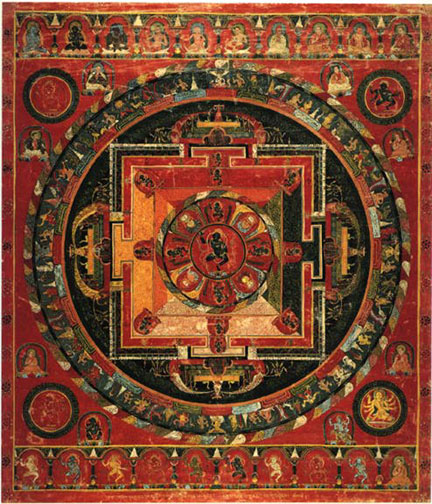| Nairatma Mandala
bdag-med-ma'i dkyil-'khor Central Tibet, Second half, 16th century 51.5 x 44.6 cm |
|
Nairatma ("She who is without ego") appears at the center of this mandala in her two-armed form, holding her characteristic attributes: skullcup, chopper, and ceremonial staff.1 She dances on a corpse in the center of an eight-petaled lotus bearing a cir
cle of deities: Vajra (E), Gauri (S), Variyogini (W), Vajradakini (N). Each figures is iconographically identical to Nairatma. The intermediate points of the compass bear skullcups atop vases, said to contain perfumes and nectars. The second circle of
deities are dakinis, also identical to Nairatma in their iconography: Gauri (E), Cauri (S), Vetali (W), Ghasmari (N), Pukkasi (NE), Sabari (SE), Candala (SW), Dombini (NW), Khecari (zenith; here, in the western gate), Bhucari (nadir; here, in the eastern
gate). An inscription at the bottom of the painting states: "The tantric practitioner (vidyadhara) Lhachok Senge (lha-mchog seng-ge) had [this thangka] made in order to make firm the life of the glorious lama, Konchok Phelwa (dkon-mchog 'phel-ba).2 Lhachok Seng e is known to have been a contemporary of the tenth abbot of Ngor monastery. Konchok Lhundrup (dkon-mchog lhun-grub, 1497-1557). As the painting's donor, Lhachok Senge may be represented in the lower right corner of the bottom register, often reserved f or a painting's donor or sacrificiant. 1 The iconography of this mandala is an abbreviated form of a mandala described in the sixth chapter of the NSP. See Mallmann, Introduction a l'iconographie du tantrisme bouddhique, pp. 47-48. 2 dpal-ldan bla-ma dkon-mchog 'phel-ba'i sku-tshe brtan pa'i phyir du/ rig-pa-'dzin-pa lha-mchog seng-ge b/hegs/mangalam// |
